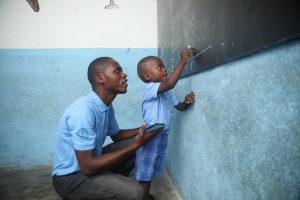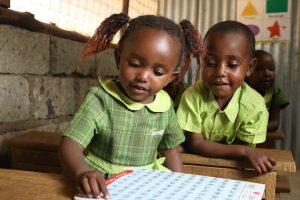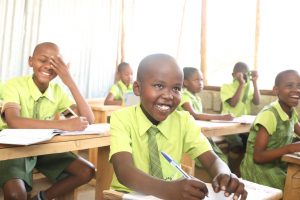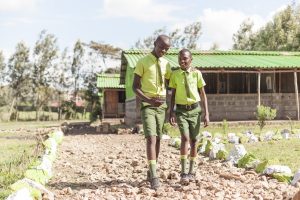The world is uniting behind the Sustainable Development Goals (SDGs). While there are different approaches and different focuses from global actors there is coalescence around the ideals that the human race needs to be freed from the tyranny of poverty; that we need to heal and secure our planet and that the world needs to be shifted onto a sustainable and resilient path.
The SDGs seek to build on the millennium development goals, eradicating poverty in all its forms and dimensions. These are big goals. They are goals that will only be achieved through collective partnership. Goals that need to embrace innovation and aspiration.
Amidst all these goals there is one that underpins the rest – SDG4; to ensure inclusive and quality education for all. Education will enable peace and prosperity, break the cycle of poverty, empower girls and drive change. Education is at the heart of the SDGs and it is the heart of Bridge, a social enterprise that has been on a decade-long journey in the pursuit of it. A journey that has evolved to see learning as science; that iterates, changes and adapts using data and evidence. A journey that began with the premise that all children have a right to quality education and that for children to learn, we must understand how they learn.
This journey has so far seen 300,000 children reached across hundreds of underserved communities in multiple countries. It is a journey that nearly a decade on, can point to success through independently verified, learning gains. As the World Bank’s inaugural Education Report emphasised, schooling is not the same as learning. At Bridge, we have always understood that it is outcomes, not inputs which should be the measure of success. As an organisation, we are always iterating and improving; learning from new global studies and conducting research on how children learn and teachers thrive.

IN THE PHOTO: Pupils in Bridge International Academies in Kenya. PHOTO CREDIT: Bridge International Academies
In Kenya, where Bridge began, almost 10,000 children have now graduated from our primary schools having sat the national exams over three consecutive years. Each year, their performance far exceeds that of the Kenyan national average; in 2017 by 10 percentage points. These graduates have defied the odds for children who grow up communities where families live on under $2 a day. Many of them have gone onto highly competitive public county level secondary schools and truly elite national secondary schools. Education has opened up a world of opportunity. Imagine what this could mean for Kenya and its development path if every single child was empowered in the same way.
It’s not just in Kenya that the approach is delivering academic success. In Uganda, our first cohort of children have just sat the national primary leaving exam (PLE), 100 percent passed. Over 93 percent achieved scores in Division 1 or 2 compared to 56 percent nationally, a statistic that drops to just 44 percent in the Eastern district of the country, where Bridge pupils sat the exam.
In Liberia, Partnerships Schools for Liberia (PSL), where Bridge is a partner, an RCT published last autumn revealed a 60 percent increase in learning in the program overall. In Bridge PSL learning was doubled, in just nine months.Combined, these results across multiple years and multiple countries, are impressive evidence of an innovative model that’s working in a landscape where public systems are often acknowledged to be failing.

IN THE PHOTO: Pupils in Bridge International Academies in Liberia. PHOTO CREDIT: Bridge International Academies
The work has been incredibly difficult, and always humbling, but it gives me immense pride to be part of a global agenda delivering meaningful change and social impact. With over 600 million children either in school but not learning or simply not in school, the scale of the education crisis and the need for innovative approaches and bold partnerships to tackle it, could not be clearer. Responding to this need, many organisations and movements are dedicated to ensuring that all children, including those in conflict areas or marginalised communities, can access an education that will empower them. An education that will enable that to reach their potential and change the economic circumstances of their families, communities and ultimately their countries.
Bridge is part of a social justice movement designed to ensure that today—not in 5 years, or 10 years, or even in 100 years, but today—children born into families that are struggling can still have access to a transformational school that will help them to reach their potential, and transcend the circumstances of their birth. The UN believes that all children will finally have access to primary education in 2042. I believe that we cannot wait until then.
There many who advocate that we should wait; that change should come slowly; that research over many years should be compiled before action is taken. These are often people who have the luxury of comfort in their lives, who do not go to sleep hungry, who have more than 2 changes of clothes, who live in nations with fundamentally strong public schools. These are the same people who advocate that a mother in Kwale County who sells second-hand clothes and earns $125 dollars a month to support her three daughters; should have to send her children to a failing public school rather than be able to choose an affordable alternative. These are the people that argue a parent in Liberia should not be able to send their child to a great free partnership school because not all children in Liberia can currently go to one of these schools. Do not benefit some, do not offer alternative options, wait until the holy grail of a strong public-school system can benefit all; is how the argument goes.
IN THE PHOTO: Pupils in Bridge International Academies in Kenya. PHOTO CREDIT: Bridge International Academies
Public system reform is often a slow and iterative process, that will be positively impacted by alternative high performing models, but while it happens the options for the mother in Kwale county are bleak. In Kenya, only 49 percent of pupils passed the national primary school exam (KCPE) in 2017. In Kwale, the county average was 218; 250 is the national pass mark. Failing to pass the primary exams means that a child isn’t eligible to go to a public secondary school, failing to get a place at secondary school means that formal education finishes just as they become teenagers and adult life begins. For the daughter of our Kwale mother, it is likely marriage will soon follow and, like her mother, she will struggle to support herself and her family. The cycle of poverty will continue.

IN THE PHOTO: Pupils in Bridge International Academies in Kenya. PHOTO CREDIT: Bridge International Academies
Her daughters deserve better. They deserve not to have their future foreclosed by the arbitrary location and circumstances of their birth. Her daughters have a right to education – but that right is not being fulfilled by the public schools in Kwale today.
So, what should the mother in Kwale do? She knows that enrolling her child in the public school is a waste of time; teachers are likely to be absent and if they are present it is far from guaranteed that they themselves will be literate. It’s also a costly option, contrary to the idea that public schools are free, they are not, coming with a litany of hidden fees.
So, she looks elsewhere. She looks for an option that she can afford and that may enable her daughter to develop into a strong, curious, thoughtful young woman. These options are few and far between, but Bridge is one. In Kwale, the average 2017 KCPE score of a child at Bridge was 273. That difference of 55 points is almost a full standard deviation. That difference of 55 points is an invitation to enrol in public secondary school. It is the difference between hope of a brighter future and hopelessness. That difference of 55 points is the difference between generational transfer of poverty and the possibility of prosperity.
To give parents a choice. To ensure that the circumstances of their child’s birth do not dictate the options for their future. Each child can learn, if they can access good schools with well supported teachers. Each child can read and write, think, dream and succeed, helping to build their communities.
Bridge is committed to an ethics of responsibility – to act given the circumstances of countries and their education systems today; given the constraints of families today, and with a steadfast belief in the dignity and possibility of every human being. To act with an ethics of responsibility requires us to be pragmatic, design-driven, empathetic to others’ conditions and committed to working together to find solutions. To advocate only for what “should” be in an ideal world does not help us get there. We believe that by offering real solutions that are delivering meaningful change, we can help make the ideal possible.
IN THE PHOTO: Pupils in Bridge International Academies in Kenya. PHOTO CREDIT: Bridge International Academies
Firstly, by ensuring that a generation of girls and boys are not trapped by poverty, but rather can stand up for themselves, pursue their dreams and fulfil their potential. When all children, rather than just those that happen to be born into wealth or live in a place that has a strong public school, can be part of building our shared future, it will be more peaceful and prosperous future.
Secondly, by demonstrating that there are immediate solutions, that the problem of ensuring access to quality education for all is not intractable, and should not take generations to fix. We should not be patient with this. Through social enterprises we are innovative enough to be able to demonstrate impact and sustainability at scale now; experienced enough to say to all countries where systems are failing that your schools can be made strong; confident enough to say that we need bold political leadership; knowledgeable enough to say that another generation doesn’t need to miss out. Quality education is possible even if schools are in conflict areas; even if countries have large refugee populations; even if communities are reluctant to educate girls.

IN THE PHOTO: Pupils in Bridge International Academies in Nigeria. PHOTO CREDIT: Bridge International Academies
We look forward to a future when all public schools are truly great and truly free, and there are enough of them for every child to attend. We will strive to help achieve that shared vision. We will do so by offering pragmatic and practical solutions. Achieving SDG4 will not happen overnight but by embracing new and innovative approaches it can happen quickly. It is possible that the mother in Kwale County can give her children a future that she herself never had.











